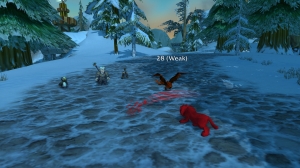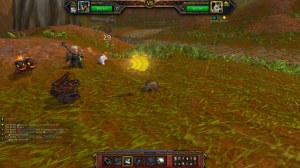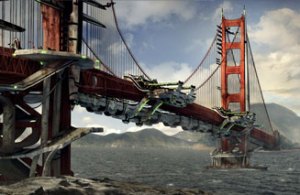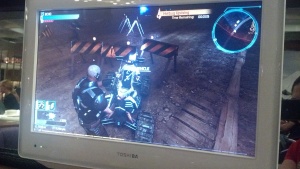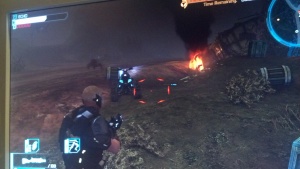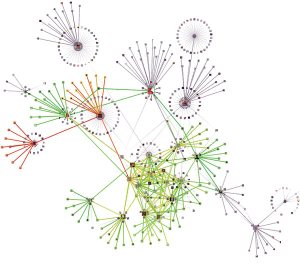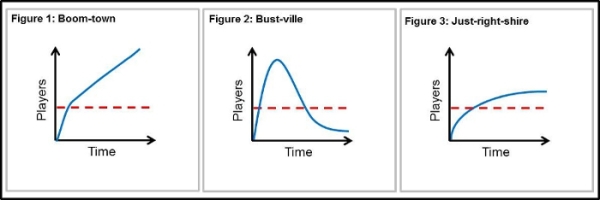Archive
Fly or Die – Status of Pet Battles in Mists of Pandaria Beta
One of the best parts about public beta tests is that they let players like me contribute to the game development process. I recently spent a bit of time beta testing the new pet battle system in Mists of Pandaria, the next World of Warcraft expansion. I’ve found that the system is not only a great addition to the game, but also a fairly unique opportunity to study how implementing a theoretical game design can often have unintended consequences. In the current beta build, population imbalance in wild pets creates an environment that heavily favors certain pet families over others. There’s plenty of time for this to change, but unless Blizzard adds a good chunk more wild Dragonkin, Mechanical, and Undead pets to the game, your best bet when the expansion is released is to grab a Flying pet and go to town.
The Mists of Pandaria pet battle system takes its inspiration from Pokemon in that players can assemble teams of pets designed to compete against pets of various types or families. The official site describes this best:
Pets are grouped into common categories called families. Families include Critter, Dragonkin, Mechanical, Magical, and there are many more. Each pet ability also corresponds to a specific pet family; Deep Breath for example is a Dragonkin-type ability, and Lift-Off is a Flying-type ability. Family determines a pet’s strength and weakness against other families. Each family also has a unique passive bonus.
The interaction of pet family strengths and weaknesses adds a strategic layer on what is otherwise a fairly straightforward combat system. On paper, each pet family has comparable strengths and weakness such that no one pet family stands out above the others. In practice on the beta server, however, certain pet families are superior to others because of a disproportionate representation of certain pet families in the wild. For instance, you are 13 times more likely to encounter Critters and 12 times more likely to encounter Beasts than you are to encounter four of the other ten pet families. This population imbalance neuters some bonuses and amplifies some weaknesses to the point of being frustrating while getting your pets to their maximum strength. Bonuses against Critters and Beasts are vastly superior to benefits against other less represented families like Humanoids or Mechanicals.
To be fair, this imbalance is a byproduct of the fact that the existing game had a lot of critters and beasts in various zones. No one can expect Blizzard to radically change the world we’ve come to expect just to account for this. Nevertheless, the current distribution of existing wild pets ends up creating a framework with the following rules of thumb:
- Flying will have a ridiculously easy time leveling.
- Mechanical, Magic, and Beast will have a fairly easy time leveling.
- Dragonkin, Humanoids, Aquatic have a fairly neutral experience.
- Critters will have a fairly difficult time leveling.
- Elemental and Undead will have a ridiculously difficult time leveling.
If you’re interested in how I came up with this, the short version is I weighted every family bonus and weakness using the relative chance of encountering a wild pet of each family type in the current beta build. If you want the longer version with tables and numbers, you can get it here on the Mists of Pandaria feedback forums (I’m Renart). The model does not predict the success of any individual pet — as some pets have multiple damage types — but it does provide a reasonable gauge of overall pet family strength across the whole of the game. Further, a family’s strength will probably vary somewhat due to uneven distribution of the family across the leveling spectrum (e.g. wild Dragonkin only exist at high level). Even with these assumptions taken into account, the above statements are probably still useful guidelines to streamline a player’s pet battle experience and avoid major headaches. Several other testers feel that these observations are consistent with their experiences.
Blizzard has about a month and a half to change the system somehow to alleviate this disparity between families. There are two things I think they could do fairly simply without reworking the whole system. First, converting as many Critter and Beast pets as possible into other less represented families whenever it might make sense would help even out the distribution. This is easiest for pets that already deviate from particular themes (e.g. A Fire Beetle that has fire skills could easily be called an Elemental with Critter skills instead of a Critter with Elemental skills). Second, and perhaps more importantly, adding a good 5-15 additional pets in the Undead, Mechanical, Dragonkin, and Humanoid families would balance out the weakest performing pet families. These two approaches combined would work best. It won’t completely remove the imbalance, but this close to release it seems like a reasonable compromise to mitigate the problem.
I’ve addressed the pet battle system previously to express my belief that it’s probably one of the boldest additions to the MMO ever in that it provides an entirely new content layer across the whole game rather than just expanding the older systems. I still feel that way. But if nothing changes between now and September 25 regarding the conditions I described above, you can bet I’ll be competing with almost everyone trying to catch and train the choice rare Flying pets in game… and probably grabbing a few Magic (+50% damage to Flying) and Mechanical (-33% damage from Flying) ones as well just to handle the inevitable onslaught of moths, buzzards, and parrots we’re all bound to run into.
Defiance: ComicCon 2012
The SyFy network and Trion Worlds are boldly fusing storytelling mediums with their hybrid television series/MMO, Defiance, scheduled for release in April 2013. The cast, writers, and lead game developers for Defiance took questions from audience members yesterday at a panel at San Diego’s Comic Con. While I love SyFy and think the story and show looks fantastic, I’m still very skeptical about whether the MMO component of Defiance can live up to the hype after watching the panel and playing the game demo available. If nothing else, I can take solace in the fact that actor Grant Bowler is involved in the project; he handled tough MMO-related questions better than almost anyone else on the panel and he’s not even designing the game.
Interplay between Show and Game
The words “Watch the show. Play the game. Change the world,” along with images of a ruined St. Louis and San Franscisco, are plastered up ubiquitously in downtown San Diego. This promise that players of the MMO will be able to impact events in the television show is the chief draw of Defiance’s fused storytelling approach. Unfortunately, how this crossover will happen was left largely to player imagination. We know the plot of the game and the show will stay synchronized with characters from the show sometimes moving back and forth between St. Louis (the show) and San Francisco (the game) to create a sense of story continuity. Several members of the crowd, myself included, asked for more details regarding the mechanics of players impacting the show or the game world, but the Trion developers side-stepped many of these questions with vague assurances that amounted “trust us, we know what we’re doing.”
The realities of TV production naturally limit the amount that the video game will be able to impact the television show, so I doubt anyone expected immediate daily impact between show and MMO, but these dismisals were less than comforting. Thankfully, SyFy’s Kevin Murphy gave the crowd a bone with possibly the most detailed explanation of the night. He assured the audience that there is already at least some interplay planned for each week between episodes where players will need to help synthesize a cure for a plague caused by razor rain, an atmospheric event caused by shrapnel from a destroyed alien ark stuck in the atmosphere periodically raining down from the sky. SyFy and Trion also have plans to hold at least one contest where a lucky player will have their character cast and placed into the live show at some point. We can probably expect this to be the exception, however. I would not expect it more than once a season.
Gameplay Impressions
The Defiance MMO is not yet in beta, but right now the game plays largely like Mass Effect 3 multi-player without dodging or cover and without class specific abilities to augment your weapons. The locked character I played was level 19 and I gained experience from killing hellbugs and completing events and challenges, but there was not a lot of information available about what leveling up does for your character. The only customization I could find at this point was equipment. You could choose your weapons (you can pick two), grenades, shield, and armor. For short movement, my character had a sprint and for longer travel I could summon a personal vehicle.
In terms of missions, I was able to participate in two events. The first was a small hellbug invasion where a massive queen-like creature kept spawning smaller hellbugs in a local region conveniently marked on my map. Two other players and I fought off waves of hellbugs while simultaneously trying to take out vulnerable glands on the big bug to get it to expose a kill point. Aiming was important to achieve this task. I opted to use a sniper rifle to take out the soft spots because the big bug had a tendency to stomp, knocking players back and doing a fair amount of damage (one hit almost knocked out my shield). The second event I participated in was a solo challenge where hellbugs were sent at me in various waves for 2 minutes and I had to kill as many as possible. At the end, my score was rated and I was awarded a bronze, silver, or gold cup and some experience. I got silver on my first attempt, but the game also showed me record holders for the event and it was repeatable if I wanted to try to best my previous score.
Overall, the game played like most other shooters, as advertised. Looking at the game map suggests that there may be several other kinds of events at release, but it is still far from clear how connected these events will be and whether they have any lasting consequences on San Francisco if players fail to complete them or not. I’m concerned that the experience may end up being fairly hollow over the life-span of the show if the game play fails to offer compelling reasons to play in San Francisco between opportunities to impact the show.
Random Facts:
There was a lot more information about the show and game discussed during the panel. A few of the better questions and answers are below.
How many races are there?
There should be eight races, at least initially. Seven alien races came to Earth in space-arks looking for a new home after theirs was destroyed. They crash and terraform Earth and now have to coexist with humans, which make eight races. We were given hints that another ark-bound race exists, but that they are more likely to appear as major villians during the story rather than as playable characters. All of the eight races are roughly human shaped so that they are all the same size for shooter balance purposes and so that a character can be easily cast and played by an actor if it needs to go to the show in St. Louis.
What happens if the show is cancelled?
Trion Worlds has contingency plans in place to keep the MMO going should the show component be cancelled for some reason. This is also why the players mostly stay in San Fransisco while the show takes place in St. Louis. I say mostly because the panel did announce that there will likely be a contest for a lucky player to have their character be cast and placed into the live show at some point, but this will be the exception and not the norm.
Will Defiance be cross-platform?
Defiance will be released on PC, XBox, and Playstation, but it will not be true cross-platform due business problems related to getting Sony and Microsoft to play well together. Also the developers believe that mixing the platforms would offer too different of playing experiences to be fair for players to compete against one another.
Conclusion:
I will definitely be watching the Defiance pilot in April, but I’m not yet convinced that I will be playing the Defiance MMO. @DefianceWorld confirmed that the game will not be free-to-play model so hopefully there won’t be too much of a barrier to fan cross-over as the story develops. If nothing else, it will be interesting to watch this grand experiment unfold.
If you have any other questions not answered here about either the show or the game, please feel free to ask in the comments and I’ll try to give you the best answer I can from what I saw and heard.
Give a Penny, Save a Penny
 Penny Arcade announced today that they initiated a Kickstarter project to completely remove ads from their site. There’s been a fair amount of hate and outrage over this decision. Most of it comes down to the fact “for three hundred dollars the penny arcade guys will install adblock plus on your browser” (courtesy of @dogboner) or “Penny Arcade breaks rule one of Kickstarter” (courtesy of @misterbrilliant).
Penny Arcade announced today that they initiated a Kickstarter project to completely remove ads from their site. There’s been a fair amount of hate and outrage over this decision. Most of it comes down to the fact “for three hundred dollars the penny arcade guys will install adblock plus on your browser” (courtesy of @dogboner) or “Penny Arcade breaks rule one of Kickstarter” (courtesy of @misterbrilliant).
Well @dogboner, @misterbrilliant, and others: you’re kind of missing the point that money kills journalism.
Sure, you can just install ad blocker to not see the ads. That doesn’t mean those ads away and the reason they exist remains. Journalism on any topic, especially in a huge industry like gaming, is an invaluable public service. Given how much money we all collectively spend on games these days, I’d hope that more people would appreciate the kind of honest feedback and criticism that PA offers its fans. I personally value their opinions and love that they are trying to be transparent about conflicts of interest. Giving them some money to help that goal is the least I can do given how much money they have saved me thanks to their coverage. [Incidentally, thanks for encouraging me to skip Prometheus, Tycho… that was $20-30 saved right there on a trip to see a bad movie.]
I was an analyst for the government and military for the past five years, so I absolutely appreciate the necessity of knowing who or what is influencing the sources information you rely on. No one can play and test every game out there, so we all rely on people like the writers Penny Arcade supports to do some of the leg work for us, finding the good games and criticizing the bad. Penny Arcade goes one step further and gives us humor too (and for free). They’re like Steven Colbert compared to Fox and MSNBC of the gaming journalism world, complete with a Penny-Arcade Nation thanks to conferences and scholarships they sponsor.
Maybe the critics prefer game coverage that reads like the author is on the company payroll and takes jabs at viewers asking questions answered in coverage they may not have read among the hundreds of websites clamoring for attention around a game’s announcement. That is totally their prerogative. If you don’t want to support the site or don’t have the means to do so, that is completely within your rights. I personally don’t pay for the New York times because I don’t think their writing is shoulders above many other news sources, but I would pay for Penny Arcade compared to many other gaming sites. I think they offer unique and useful coverage and would hate to see them succumb to the whims of advertisers.
So today I am going to be one of those people pledging help Penny Arcade achieve their goal. Choose not to if you want, but just remember to thank those of us who do when the quality of the site improves and you reap the rewards for free.
End-Game Primacy: Part 3
Part 3: Squaring the Circle
If you’re reading this you probably either came straight from the Introduction or were patient enough to work through Part 1 and Part 2. For simplicity, here is the short form of my theory on the ideal MMO content:
End-game primacy is the idea that the bulk of any MMO development time needs to be spent on maximizing end-game content and that this goal is best achieved by embracing complex systems driven by player interaction, rather than static content. Or put a different way: an MMO’s real story begins after the scripted story ends.
As I discussed in part 2, complex systems can be consumed by players longer than static content, but they are also significantly harder to create well. What works in a single player game may not work in an MMO, and vice versa. It is a lot easier to account for a few players’ actions than it is to predict the impact of millions. Millions of players is millions of opportunities to undo any work developers put into the game. Structured static content offers a lot more control for developers. Instancing, phasing, personal stories, and other tools isolate players from the larger game population, while simultaneously making it easier to tell a story to the player. It lets developers preserve the narrative format of single-player games. In contrast, unstructured simulations take control away from a development team. The simulation elements are built into the game world and then left to the players’ whims on what to do with them. This is a frightening prospect because systems not designed to scale particularly well can tend to spiral well out of control, at the detriment of other aspects of the game. For instance, if players can build structures on game landscape, the game world will almost definitely end up suburban. If players can build in a particular spot, they will if for no other reason than they can. Expecting that it would not happen is betting against the odds.
Qualities of Good End-Game Content:
End-game content systems needs to ebb and flow organically, self-regulating through internal feedback mechanisms. In the above example of players building on the terrain, physical game space is limited while the numbers of players who can (and will) build houses has no theoretical limit. Instancing off the construction projects or expanding the physical land mass using some kind of terrain generator are two ways you can address the finite space. I’m not stupid enough to think that the second of those two options is exactly feasible. In many cases, it may be impossible. The alternative of instancing off construction projects or imposing artificial limits on where players can build to control the urban boom misses the point of building a game with lots of players in the first place. To make the system work, there needs to be a natural feedback mechanism in place. For housing, if players can create them – they must also be able to destroy them. Determining the ratio between building and destroying would require a fair amount of find tuning, however. If it’s hard too build and easy too destroy, no one will bother building. On the other hand, if it is to easy to build and to hard to destroy, you still end up with a sprawl.
Going back to Part 2, auction houses have natural self-regulation through the invisible hand of supply / demand, but they lack a mechanism to contribute to player narrative. Systems that have ways to report activity and interactions back out to players are another hallmark of a good end-game system. Players can buy and trade all day on the auction house, but if there is no mechanism to report major fluctuation in trade, players will likely feel isolated in their game experience. Even if such a mechanism exists, it probably does not tie into other systems. Ideally, if a market change occurs, it should be in response to in-game events. Knowledge of these events provides players immersion, rather than just leaving them staring at a user interface spreadsheet tracking their purchases. A good end-game content system will let developers track and aggregate player interactions within and across systems to facilitate narrative development. In the housing example above, a mechanism to monitor and encourage players to cluster buildings together facilitates the construction of towns instead of haphazard sprawl. For instance, perhaps building in close proximity to one another increases their natural defense. Two houses have the defense of three; three the defense of five; and so on. A shack in the woods could be torn down in a few minutes, where several dozen buildings together takes over a day. Several towns merge to form a city which takes a week to siege. And each of these units (e.g. town, city) provides an entity that developers can track and use as a piece to a personal player narrative that is not separate from all other player narratives.
An Opportunity in Player Social Landscape:
These are simplistic examples, to be sure, but it gets to the point of what I’m trying to explain. I cannot suggest an end-game system that will work in every MMO. Each game has its own limitations based on engine, design philosophy, resources and a host of other factors. However, there is one area in many MMOs today that I believe remains underdeveloped, but which also has great potential to add depth to end-game experience and help developers create quality evolving narratives in the process. While most developers spend plenty of time shaping their landscapes and dungeons and are loathe to let players ruin that art, social terrain is an area that does not currently have structure and therefore cannot be destroyed.
The fact that I can often only be the member of one guild and my relationships to other players are defined as “friend” or “not friend” is fairly simplistic. This flat and binary social structure is surprising given that large numbers of players are a feature of MMOs. Certainly, social terrain is difficult to communicate meaningfully – even Facebook struggles with it – but games need more than a few binary associations to link players. In life, we play many roles and in games we do as well. Is there a particular reason that a player can and should only belong to one guild in a game? I would argue no. Further, guilds are generally the only mechanism to permanently join players in games. This is an artificiality that misses the point. Letting players create different kinds of associations among themselves and build on the quality of those relationships through game play would be a fantastic way to add depth to a relatively one dimensional system.
Imagine if player organizations came in many different forms, which were not binding to individual players. Guilds might still exist as the highest form of player grouping, offering resources like shared banks and chat channels. Others might exist for circles of friends to communicate. These circles could extend between guilds and offer benefits like being able to travel immediately to your friends’ location. Still others might exist for trade groups: players who regularly share crafting resources to each others’ benefit. Being a member of this group may offer additional crafting benefits. Player organizations like this only come into existence when the game recognizes a cluster of individual player associations strong enough to warrant it. When players “friend” one another they select the kind of relationship they want to build. Small groups of friendship-linked players might warrant a “friend circle,” clusters of adventuring-linked players might warrant a “guild circle,” and clusters of trade-linked players might warrant a “trade circle,” and so on.
These interlocking social circles would create an inherently organic system that already lies on top of almost any game’s existing game play. Anchoring these circles into less organic game systems could vastly improve and regulate end-game play. For instance, if a game allows players to fight for control of game regions, a map which only has guilds will be one dimensional. Add in trade organizations that may operate across regions and suddenly you have two dimensions with the same players. This in itself is a story, and one that with the right tools can be communicated back out to the players. Using the housing example above, anchoring the ability to build houses to player associations may be a way to organically limit the growth rate of construction in a game. Player groups may be the unit to build (instead of players) and they may only be eligible while the quality of relationships between members remains high enough. Social pressure does the rest. Capture that narrative and push it back out to the affected players and perhaps one or two tiers out (using the same association network). Players would learn about attacks on towns that their friends live in or where their trading partners do business. The game tells a story that people care about. By necessity, this needs to occur in near-real time, a challenge in itself, but done right could absolutely change the face of MMOs today.
Conclusion:
As you can guess, there are a lot of things to consider in anything as complex as a virtual world, so these theories are as much a work in progress as anything else. I hope that they were, at least, somewhat thought provoking. There are plenty of technical limitations preventing much of this from happening in the near future, but adding one new end game system to new MMOs should not be out of the realm of possibility. Hopefully over time some of those will be captured as best practices and replicated out, leaving room for newcomers to add even more dimensions to virtual world game play.
End-Game Primacy: Part 2
If you don’t know how you got here, head back to the Introduction or Part 1. Otherwise, read on:
Part 2: Building the Theory
In a perfect world, developers would just make content all the time to keep players of all kinds entertained by the game world, but that is not possible. Developer resource constraints limit how much content a team can produce in any given amount of time. As a result, there is a natural design triage where teams must choose to implement new features that can most positively impact the game. I have seen people suggest before on forums that this problem can be solved by hiring more programmers, designers, and artists. That is not a real solution because the numbers you would need to hire to eliminate the problem are probably staggering. Further, that many people would bring a host of of organizational issues that would probably impact quality in unintended ways. Given these issues, I am not even considering that avenue an acceptable solution to the problem.
Further, resource constraints are not a problem unique to the gaming industry. In the military, people who didn’t understand the principles were described as “good idea fairies” because their decisions resulted in ineffectual changes that only served to drain resources in time, money, and manpower without actually effectively improving a situation or organization. Unfortunately, the military has been so awash with resources over the past decade, much of this behavior isn’t penalized the way it should be. That is not an option for a gaming business. So I’m going to assume that, at present, the average developer produces content at a mostly fixed rate thanks to effective resource allocation. The way to improve the output of the equation is to find ways to make the content created last longer when faced with players’ content avarice. This is no small feat, given that even veteran game companies sometimes fail to retain players. I cannot claim that it is fool proof, but I think it is possible.
The Theory:
Accepting the reality of resource constraints leads to the first half of end-game primacy: the bulk of any MMO development time should be spent on maximizing end-game content. Most MMOs embrace some form of individual progression system where players consume static content until they finally hit a hard cap on player development. Any content consumed along that progression track essentially comes with an expiration date. It is only consumed for a very small portion of a players overall game experience. In contrast, content at the end-game can be–and is–consumed for much longer, even when it is static. If enough static content exists at the end-game, developers can eventually issue an expansion, pushing the progression wall a little further and starting the cycle over. The most successful games already embrace this half of end-game primacy. Others spend too much time on the initial progression, expecting to have time to expand later only to realize their players did not feel like waiting around. While even this strategy can work, pushing static content to players is still limited. Players still consume it and content themselves with repetition and brand loyalty as the glue that keeps them around long enough to see the next cycle.
Arguably the method of pushing static content is more in line with standard software development practices like object oriented design and agile development. If that was the only way to build content, I think it would be the best way given those advantages, but there is another option. Going back to Ralph Koster‘s quote from Part 1, I want to highlight a particular portion:
You can try a sim-style game which doesn’t supply stories but instead supplies freedom to make them. This is a lot harder and arguably has never been done successfully.
There have been a few attempts at more sim-style content over the past few years, but it is definitely the harder model to do right. That is probably why so many companies choose the safer route. The second half of end-game primacy is that complex systems driven by player interaction provide more longevity than static content. These systems differ from static content in that they allow players to pull content on-demand. An example found in many current games is an auction house. An auction house is always there for players to engage in when they want it. Some players will use it some times, others will use it never, and a rare few will use it as if it is the game itself. It provides a constant stream of content that becomes more dynamic and interesting the more players interact, improving the game play experience for everyone. It can go for years without ever losing player interest, providing maximum impact for developer resources spent. Even if player progression is expanded, the auction house grows with that new bound, while older static content like dungeons generally get left behind.
Limitations:
On paper, dynamic systems like auction houses are superior to static content because they offer players new experiences over longer periods of time. I recognize, however, that they are not all quite so easy to make in practice. Economic models are fairly well developed, so predicting player economic behavior is substantially easier than say, predicting how a player will respond to a powerful monster or even another player. These models make it easier for developers to build tools and mechanisms to govern that behavior (like the auction house) but modeling social behavior is a different animal. Implementing many player versus player systems, for instance, end up being a lot like trying to make a communist economy. It is great in theory, but horrible in practice. There are few games that successfully implement player versus player mechanics and end up with a lot of digital pacifists running around cooperating.
Given these challenges, the end-game systems need to be designed in such a way that they do not cause more harm than good — no small task, to be sure. If this can be accomplished, I feel the amount of development time that these systems entail far outweighs the benefits of spending that same development time creating static content. The initial upfront investment might be higher, but over the long run they end up costing far less in terms of resources. Taking in total, these ideas all left me with the conclusion that bulk of any MMO development time needs to be spent on maximizing end-game content and that this goal is best achieved by embracing complex systems driven by player interaction, rather than static content.
But a principle is only useful if you can make good on it, so in Part 3 I will give a few of my ideas on building meaningful simulations at the end-game of an MMO.
End-Game Primacy: Part 1
Part 1: Exploring Principles:
To suggest that I have a better way to build an MMO is to suggest that there is a problem with the current model. That’s not being entirely fair because there are plenty of good MMOs out there right now. However, it has been my experience as a player that innovation seems to have slowed as more developers choose to replicate the same MMO models across new franchises rather than take big risks of new kinds of MMO game play. My theory is meant to be an alternative, and I hope justification for someone to build this concept. I’m going to start with what I believe needs to be the ultimate goal of any MMO and then work backwards on how I think there is a better way to reach that goal that not only makes a better game for players, but also meets the business needs of developers and producers.
1) Successful MMOs need player volume to make money. Massively multi-player online games are inherently expensive to produce and maintain. From a business model standpoint, this means that the game needs to attract enough players for a long enough period of time to recoup initial development costs, provide future maintenance and development costs, and also make a reasonable profit for the developer and producer. It doesn’t matter if the business model is free to play with micro-transactions or subscription based. A consistent player volume is required for both. This need for money is a hard truth to swallow for those most passionate about these games (myself include) because we tend to idealize the art form. But a healthy player population is not only good for business, it’s also good for game play too (more on that in a moment), which is a goal even the most doe-eyed idealist gamer can get behind.
2) A stable population is a function of player retention . To reach the idealized population sweet spot where the game world is bringing in enough money to meet the above objectives, players need to be retained over a period of time. In an ideal world, which I’m going to refer to as “Boom-town” (figure 1), players will opt into the game world and choose to never opt out. This would result in near continuous growth as more and more players try the game. The second scenario, which I’m calling “Bust-ville” (figure 2), shows what happens with many MMOs these days. Players flock to the new game, but their average retention time isn’t long enough to let new players replenish their ranks. The population falls below the theoretical “healthy population” line and fails to make enough money or keep game play interesting enough to attract new players. The last scenario, or “Just-right-shire” (figure 3), is the most realistic goal. The initial spike of players is high enough to get above the healthy population line, and average player retention time is long enough that the population never drops below that line. The game reaches a state of equilibrium or steady sustainable growth.
3) Player retention is tied to content relevant to a players interest. If content is relevant to a players interest, it should theoretically be fun for the player. As long as that content exists, the player should be retained. It sounds simple, but it’s honestly where this gets wildly complicated. Not surprisingly, fun is different for different people. Some players will be attracted to story, others to exploration, others to combat with other players. Most will move back and forth between all of these elements at various times during their retention. There simply is not enough time and resources to make content to appeal to everyone at all times. Even if a game developer decides to focus on appealing to a narrow population group, players consume this content far faster than developers can make it. Consider the quote below from Ralph Koster:
If you write a static story (or indeed include any static element) in your game, everyone in the world will know how it ends in a matter of days. Mathematically, it is not possible for a design team to create stories fast enough to supply everyone playing. This is the traditional approach to this sort of game nonetheless. You can try a sim-style game which doesn’t supply stories but instead supplies freedom to make them. This is a lot harder and arguably has never been done successfully.
Koster is specifically talking about stories, but this holds true for if you substitute any kind of content for stories. Even the most successful MMO development teams today struggle content fast enough to keep their players from consuming it too quickly. At best, they skirt keeping their populations above the healthy line with injections of content as expansions. At worst, they experience Bust-ville, where their initial content release and subsequent content production is too slow to keep player retention up long enough to see population stability. Repetition and pseudo-random elements in the static content can alleviate this somewhat, but these are band-aids to the larger issue. Other variables like brand loyalty or lack of competitors can also extend the life of this content, but they still cannot compete with new content. Even the best roller coaster in the world gets boring after the one hundred forty-seventh time for all but the most extreme roller coaster enthusiasts.
Continue reading more Part 2: Building the Theory or head back to the Introduction to navigate from there.
End-Game Primacy: Introduction
This month’s posts are going to go a bit more abstract and theoretical than the last few I’ve written. This is intentional. While talking about popular upcoming games might draw more traffic to the site, I feel that recently I have not put enough of myself into this blog. I love talking about other games because I love playing them, but those other games were never meant to be the centerpoint (at least not until I’m making them). So today I want to share a working theory I have about how to improve the quality of MMOs today. This theory has developed over time based on reading, personal observation and experience, and many conversations with friends patient enough to listen to me. Here is is up front:
End-game primacy is the idea that the bulk of any MMO development time needs to be spent on maximizing end-game content and that this goal is best achieved by embracing complex systems driven by player interaction, rather than static content. Or put a different way: an MMO’s real story begins after the scripted story ends.
To keep this manageable, I broke my ideas down into three sections. Publishing each part on different days might drive more traffic to the site, but I decided I would rather put this all out at once since it needs to stand together. If you already agree with end-game primacy after reading the short version above, free free to skip to part 3 where I offer some ideas on how to implement it. If you want to see how I came to the theory, go onto part 2. Or if you want to see me talk about some basic concepts related to MMO business models, head to part 1. I hope that this breakdown will also make it easier for people to comment on various sections. Since this is the first time I’m posting this way, please provide feedback if you prefer this format for longer posts. And with that out of the way, I give you my opus:
- Part 1: Exploring Concepts. Development of principles leading up to end-game primacy.
- Part 2: Building the Theory. Construction of the end-game primacy theory.
- Part 3: Squaring the Circle. Ideas on how to build meaningful end-game content.
I rescued the princess!
The Quest is usually a tag I use to talk about my personal attempt to break into the game development world. Today’s post isn’t about that but it has been over a month since I last post here, and I wanted to explain my absence from the site. As that reason was personal, I’m tagging this as a part of the Quest.
I’ve been grinding you see.
No, not grinding for gear in Diablo 3 or levels in some other game. Rather, I’ve been sneaking around my girlfriend getting her a ring made; grinding cash into diamonds. Last weekend, I proposed and she said yes. And there was much rejoicing! Many who read this blog regularly already heard that news, but I felt everyone else should know too.
But, wedding planning aside, I’m back now and I have a few irons in the fire that I think will be fairly interesting once I pull them out. Early next week I plan to post a fairly long piece about storytelling and simulation. Hopefully shortly after that, I’ll have a piece about social media’s influence on game development (which will have math!). And to top it all off, my fiancee and I will be going to ComicCon next week. If I find out anything cool, interesting, or otherwise awesome, that will be included in an update once I get back.
So thanks for your patience and please check back regularly.

